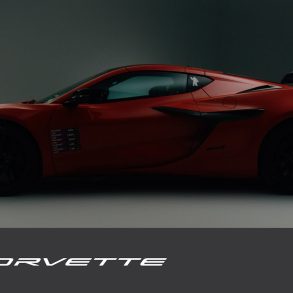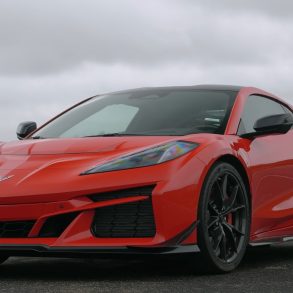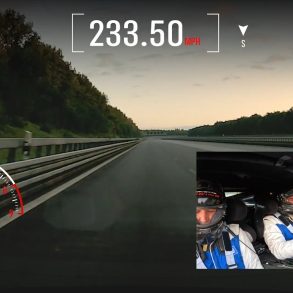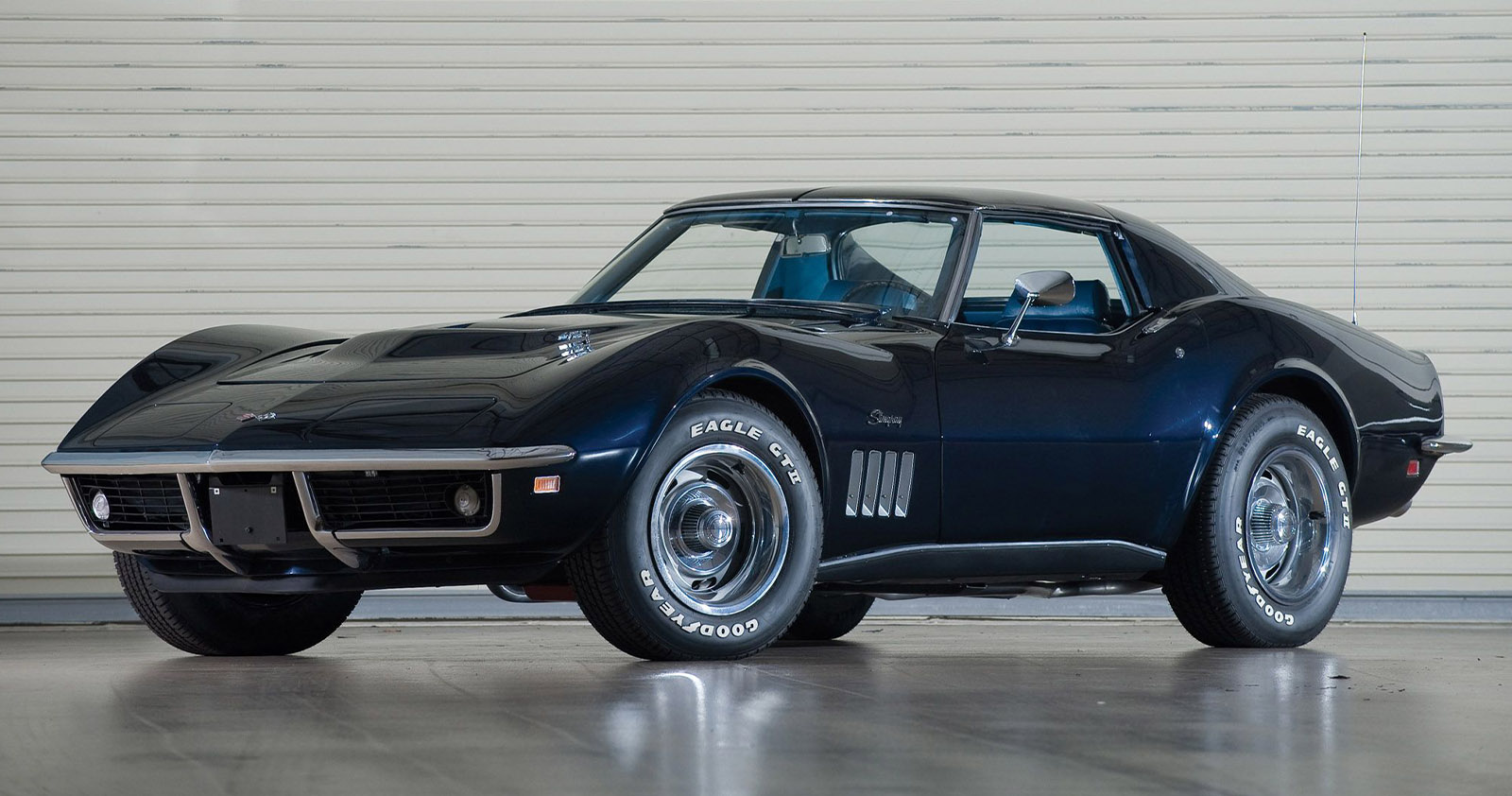“There is an insatiable thirst in the sports car world for the ultimate in performance. And the ZR1 is certainly that in the Corvette lineup. It’s at the very top.” – Josh Holder, Corvette Chief Engineer
While the eighth-generation Corvette has certainly pressed the boundaries of speed and performance with each, new iteration (including the ERay and Z06 models), Chevrolet has created a bonafide hypercar that can outrun/outperform cars many times its price point. For 2025, Chevrolet unveiled the all-new Corvette ZR1, a 1,064 horsepower, 828 lb-ft of torque monster that truly makes this Corvette “the King of the Hill.”
To fully appreciate the raw power of this Corvette, we need to drill deeper into the mind-bending specifications that General Motors, Motor Trend, and other reputable automotive news sources have already published. Before we jump into the numbers, however, we want to point out that Chevrolet has achieved this unprecedented level of performance while also producing the 2025 Corvette ZR1 in both coupe and convertible variants.
- The 2025 Corvette ZR1 features a 5.5L, twin-turbocharged DOHC flat-plane crank V8 engine that has been officially designated as the LT7.
- As previously stated, the LT7 engine produces 1,064 horsepower at 7,000 rpm and 828 lb-ft of torque at 6,000 rpm, per SAE guidelines — the most power ever produced from a factory Corvette and the most powerful V8 ever produced in America from any auto manufacturer – EVER.
- Corvette ZR1 boasts a top speed of over 233 mph on the racetrack and will dispatch the quarter mile with a GM-estimated sub-10-second time.
- The ZR1’s purposeful carbon fiber aero package creates over 1,200 pounds of downforce at top speed.
- The 2025 Corvette ZR1 revives one of the most iconic styles in Corvette history: the split rear window.
“The team that revolutionized Corvette with a mid-engine architecture took on another challenge: take ZR1 to the next level,” said Scott Bell, vice president, of Chevrolet. “Corvette ZR1 is about pushing the envelope with raw power and cutting-edge innovation. From Stingray to Z06, E-Ray, and now ZR1, the Corvette family continues to elevate with each new iteration — and challenge the best in the world.”
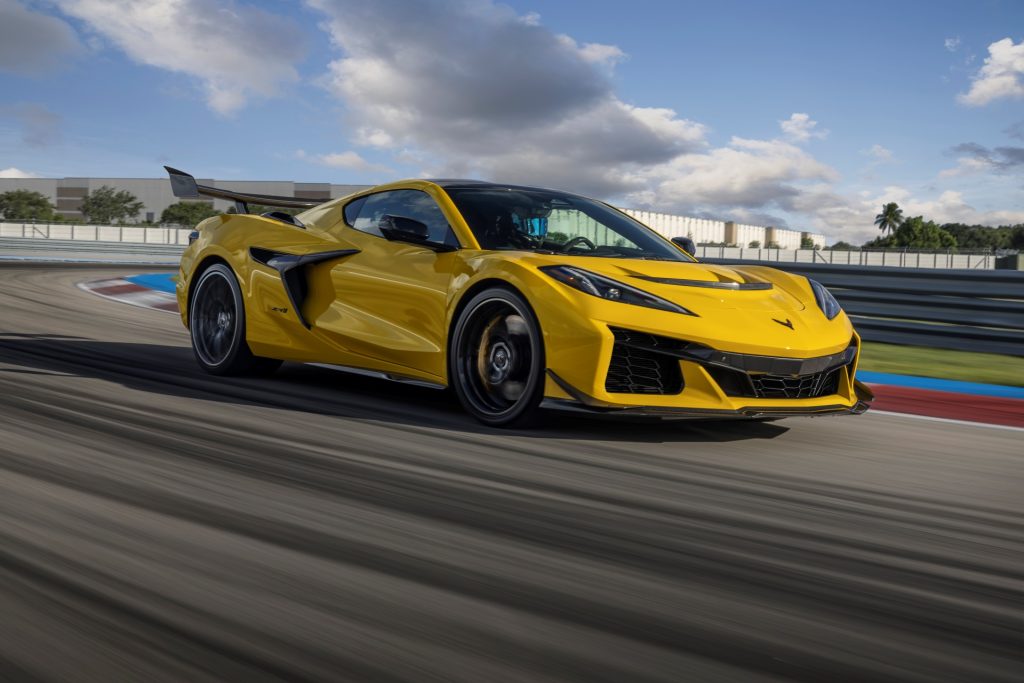
Pushing the Limits of Engine Development
The development of the 2025 Corvette ZR1’s 5.5L LT7 twin-turbocharged DOHC V8 engine began with the same engine architecture as the 2023 Corvette Z06’s LT6 engine, which remains the most powerful naturally aspirated production V8 engine to date. Building upon that architecture, the LT7 takes that power to the next level with the introduction of twin turbochargers — the first time such a configuration was included in a factory Corvette.
Dubbed the “Gemini V8” architecture, the LT6 program became the foundation for engineers to achieve a dual-pathed objective: To create massive power, capability, and character from a naturally aspirated and turbocharged flat plane crankshaft twin engines. With these goals in mind, General Motors engineers did not simply recreate the Z06 Corvette’s LT6 with turbochargers, but instead changed and optimized virtually every system for the boosted application found in the new Corvette ZR1.
The 2025 Corvette ZR1’s 5.5L, twin-turbo DOHC flat-plane crank LT7 engine is the result of unrelenting engineering prowess and the team’s desire – and determination – to push the boundaries of what this platform could produce. The result is a perfect fusion of performance from forced induction with the already robust 5.5L engine’s flat-plant architecture.
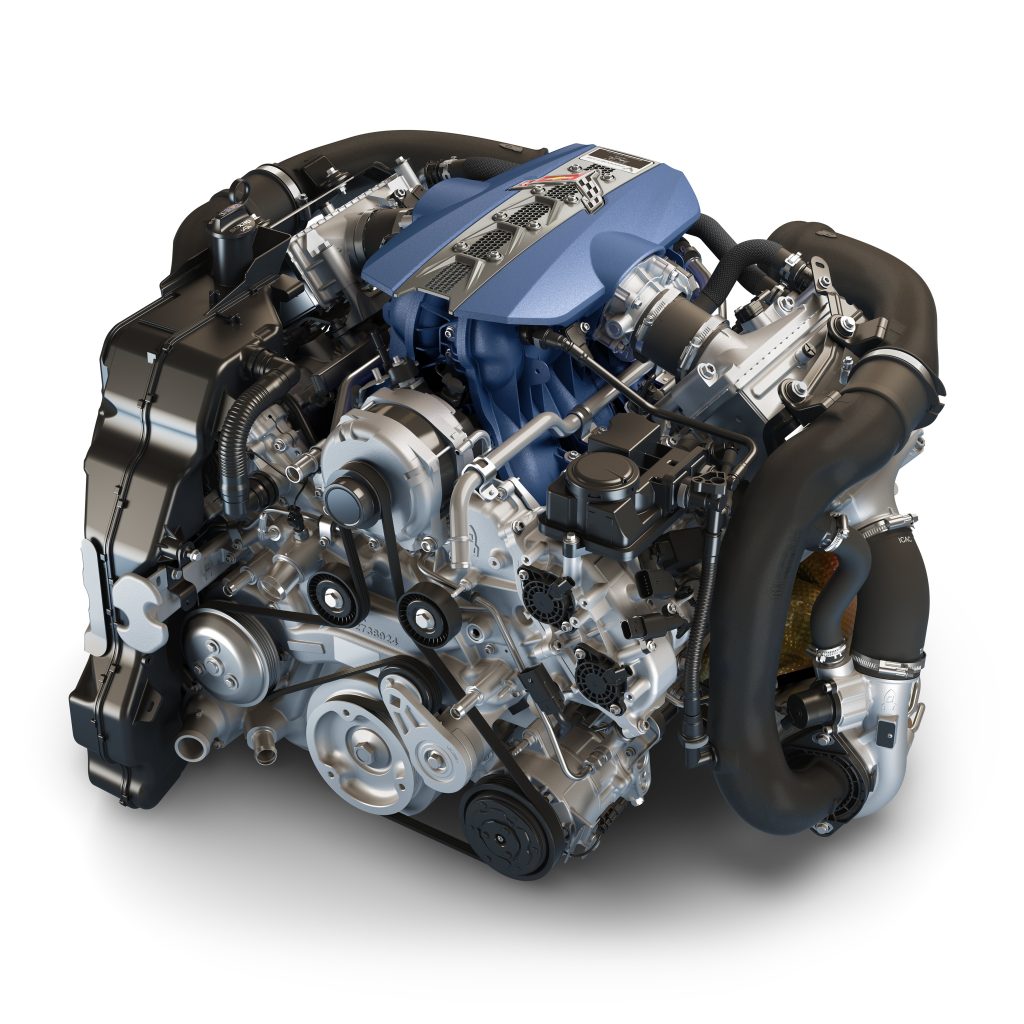
But just how different is the LT7 from the LT6? To answer that question, we need to “drill into” the architectural nuances that separate the two platforms. Here are some of the key components that separate one from the other.
Unique to the 5.5L LT7 twin-turbo V8:
- Head castings with unique ports and a larger combustion chamber.
- Valve train timing and lift profile optimized for forced induction with higher exhaust temp enabling exhaust valves.
- A completely new intake system tuned for twin turbochargers.
- A CNC machined combustion chamber, exhaust and intake ports specific to the LT7.
- Dual, ported shroud, ball bearing, mono-scroll (76 mm) turbochargers integrated with the exhaust manifold to reduce the volume and distance from the exhaust valve to the turbine wheel for quick response with electronic wastegates.
- Intelligent anti-lag engine calibration techniques specifically for ZR1 that adapt and react to driving style.
The LT7 engine also builds upon this engine architecture with:
- Added block and head machining to support turbo cooling and oiling
- Counterweight changes to account for a unique piston, and unique connecting rod for the crank train
- A secondary port fuel injection system added to deliver the needed additional fuel to support the engine’s massive output
Of course, bolstering the engine output of the 2025 Corvette ZR1 also meant that the rest of the powertrain received the necessary upgrades to support and reliably transfer all that horsepower and torque to the road. To support the dramatic increase in output from the LT7 engine, engineers made numerous upgrades to the Corvette ZR1’s eight-speed dual-clutch transmission, including:
- Upgrades to the inner and outer input shaft assemblies.
- Increased gear capacity with strength increased via shot peening for all gears.
- Final drive refinements.
- Oil management to support increased vehicle longitudinal and lateral capability.
- Increased control valves to accommodate the higher required clutch clamp load for LT7.
Each LT7 engine is hand-assembled by the master engine builders at the Performance Build Center, part of the Corvette Assembly Plant located in Bowling Green, Kentucky.
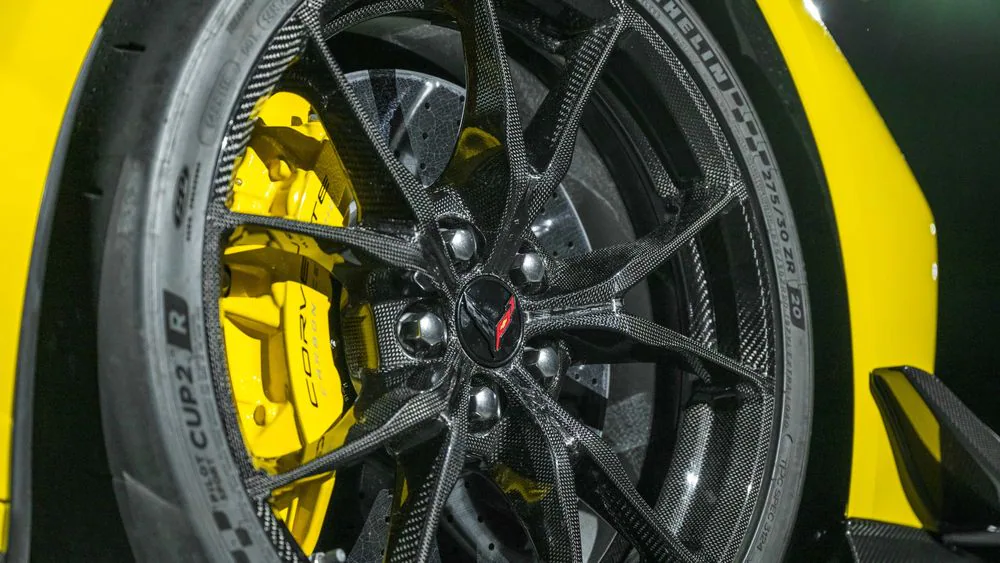
Form Follows Function – Architecture of the Corvette ZR1
It is important to understand that while the 2025 Corvette ZR1 was built around the same, foundational infrastructure as the earlier variants of the C8, there was a considerable amount of engineering that went into advancing the platform to properly utilize and support the massive power it produces. This includes the introduction of purposeful aerodynamics packages designed to provide the most downforce ever from a Corvette with over 1,200 pounds of downforce when operating at top speed. Two distinct setups, complete with Magnetic Ride dampers, enabled GM to accomplish this.
The standard Corvette ZR1 chassis comes equipped with a sleeker body intentionally designed to lower drag. This setup includes a smaller spoiler with customer-adjustable short and tall wickers. It also includes a standard carbon-fiber front splitter, rocker moldings, side intake with integrated brake cooling, and front underwing with stall gurney deflectors. Michelin Pilot Sport 4S tires wrap 20-inch front, and 21-inch rear wheels. The standard chassis blends the best of on-road comfort and track capability with this setup.
Even with the standard configuration, the 2025 Corvette ZR1 can navigate the world’s toughest tracks with ease, not only with the power produced by its 5.5L LT7 engine but also due to additional, specific aerodynamic and cooling changes found throughout the car. These include:
- A flow-through hood: Air enters the front grille, flows through the intercooler heat exchanger, and exits the hood to increase front downforce and cool charged air temperatures.
- Carbon fiber side profile air ducts: Clean, cool air is funneled through ducts, which are cleanly integrated into the signature wishbone bezel behind the cabin doors to cool the rear brakes through an intricately designed system that doesn’t impact rear wheel travel.
- Unique fresh air intake ducts: Carbon fiber inlets located on top of the coupe rear hatch ingest air to cool the turbo compressor inlet air temperatures.
For consumers looking to fully harness the car’s massive performance capabilities, the 2025 Corvette ZR1’s optional ZTK performance package unlocks a true track weapon. Notably, the ZTK package adds an aggressive, high-downforce rear wing, front dive planes, and a tall hood Gurney lip – all constructed from woven carbon fiber. Underneath, underbody strakes replace the standard front underwing stall Gurney to increase front downforce. The suspension tuning included in the ZTK package incorporates stiffer springs and adds Michelin Pilot Sport Cup 2 R tires. Amid testing and development, the ZR1 tackled some of the world’s most demanding racetracks, including the Nürburgring, Road Atlanta, and Virginia International Raceway.
Carbon Aero, featuring all aerodynamic equipment from the ZTK package, is available on the standard ZR1 chassis as well.
“We went into the ZR1 program with lofty goals, but even our first development tests on-track showed the teams were already exceeding them,” said Tadge Juechter, executive chief engineer, Corvette. “As we worked to develop this car, we continued to leap past expectations, and we knew we had a special Corvette on our hands.”
To ensure the newest ZR1 can manage all of the power, Corvette engineers developed a new braking system for this latest iteration of its “King of the Hill.” The brake package uses a revolutionary carbon ceramic rotor manufacturing technology to yield increased durability and reduced brake component temperatures. The 2025 Corvette ZR1’s front rotors measure 15.7 inches (400mm) in diameter – the largest front rotors ever factory equipped on a Corvette – and its rear rotors 15.4 inches (390mm) in diameter. In just 24.5 seconds, the Corvette ZR1 goes from 80-200 mph and back to 80 mph — making it 22% quicker than the C7 Corvette ZR1, and 53% quicker than the C6 Corvette ZR1.
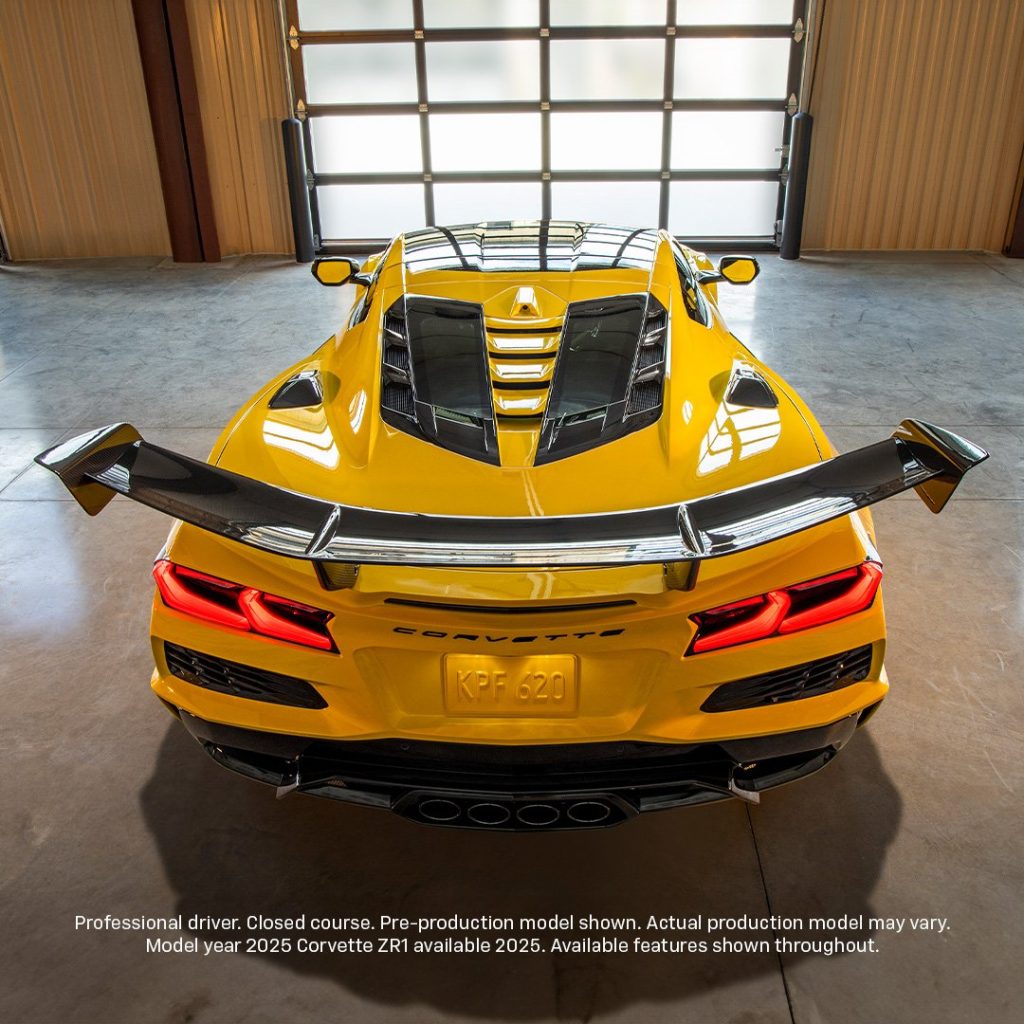
An Enduring Legacy – Return of the Split Window
As the 2025 Corvette ZR1 represents the epitome of the Corvette brand, the team at Corvette, keeping the “form follows function” mantra in mind, incorporated a design architecture back into the car to create an instant iconic styling element not seen since its initial introduction in 1963.
“We didn’t approach this decision lightly, we know this is a beloved element from Corvette’s history,” said Phil Zak, executive design director, Chevrolet. “Not only does this element provide function, but we were able to integrate passionate design into the form and do it in a way that paid homage to Corvette’s history. ZR1 felt like the right time to bring the split window back.”
Last seen on the C2-generation Corvette, and quietly previewed on the Corvette Z06 GT3.R race car, the split-window style capitalizes on the design statement that is Corvette ZR1. While serving as a statement piece, this carbon fiber “spine” between the two rear windows, available in exposed weave or body color, provides increased heat extraction from the engine compartment, working in parallel with numerous other cooling elements throughout ZR1.
The engineering and design teams worked to elevate the striking design first revealed with the eighth-generation Corvette Stingray in 2020 and to accentuate lines that evoke the car’s sense of motion — but the design’s function also helps it perform. Teams looked at every component of Corvette ZR1 to ensure cooling and aerodynamics remained top of mind, and any change accomplished the car’s mission: unbridled performance.
As has been synonymous with the 2025 Corvette ZR1 throughout the development of its engine, transmission, braking system, chassis, etc., the exterior of the car also received upgrades specific to increasing the performance of the ZR1 architecture. These included:
- A fiber roof to reduce mass and lower the center of gravity for both the coupe and convertible models.
- A unique aluminum wheel design available in four finishes, including Edge Blue — an homage to ZR1’s signature color cue.
- An LT7 engine intake finished in Edge Blue — resulting in an engine that looks as good as it performs.
- Optional new carbon-fiber wheel design, exclusive to ZR1, to reduce unsprung mass by 42.8 pounds
Similarly, the design team responsible for the 2025 Corvette ZR1’s cockpit spared no expense “dialing up” the interior aesthetic, and it shows with all the attention to detail found therein, most notably with unique ZR1 badging found on an interior plaque, the sill plates and steering wheel. A new finishing stitch pattern for the doors, specific to ZR1, is available on the 3LZ trim. A boost gauge is also present, denoting the first factory turbocharged Corvette in the nameplate’s history.
Providing further choice to customers, the Corvette ZR1 features a roster of customization between exterior and interior colors. Shared with the 2025 Corvette lineup, new colors include Competition Yellow, Hysteria Purple and Sebring Orange. The latter recalls a fan-favorite hue from the previous C7-generation Corvette ZR1, while the Competition Yellow provides consumers with a return to the color yellow found on the Pratt Miller Z06 GT3.R race cars
Inside, a new Habanero interior is available, as is a Blue Stitch option. Various full-length racing stripes, brake caliper colors, including an exclusive blue for the calipers, seat belt colors, and more.
To review the complete list of options available on the 2025 Corvette ZR1, and/or to begin putting together a list of options for your potential ZR1 allocation, please click the link below for Chevrolet’s official ZR1 order guide.
2025 Chevrolet Car ZR1 Corvette
Pricing and Availability
The Corvette has always been marketed as the “affordable” sports car, and the 2025 Corvette ZR1 (considering what you receive for your money) is no exception. While it’s true that the MSRP on this car may be out of reach for many household budgets, it is worth noting that the price point on the ZR1 is considerably less than on other cars with similar power and performance specs.
The pricing is as follows:
- The 2025 Corvette ZR1 coupe, when equipped with the 1LZ trim level, starts at $174,995, while the 3LZ coupe is a bit more at $185,995. If you are looking for a convertible ZR1 in either of these trims, you’ll add a $10k premium to the price.
- The Carbon Fiber Aero package adds another $8495 to the price of the ZR1 and is required when ordering the ZTK package. Please note that the ZTK package sells for an additional $1500.
- As of April 5, 2025, Chevrolet is still waiting for EPA certification on the Corvette ZR1. This is significant because the pricing listed above does not include the mandatory gas-guzzler tax, which will increase the final MSRP for the 2025 Corvette ZR1. The 2023 (and later) Corvette Z06 was tagged with a $3000 gas guzzler tax when introduced, so it is expected that the gas guzzler tax on the ZR1 will be at least that much (and possibly more.). We will provide updates as they become available.
- Chevrolet began accepting orders for the Corvette ZR1 in February 2025, and production is scheduled to begin in the second quarter of 2025. Final pricing (including taxes, delivery fees, etc.) can be determined by your local Chevrolet dealership. Please contact them directly for any further information related to pricing or when inquiring about how to order your 2025 Corvette ZR1.
We’ve included the following pricing guide reference for the 2025 Corvette ZR1 as compared to comparable cars in the super/hypercar market segment:
| Competitive breakdown | |||||
| 2025 Chevrolet Corvette ZR1 | 2024 Porsche 911 GT3 RS | 2022 McLaren 765LT | 2024 Ferrari SF90 XX | 2025 Lamborghini Revuelto | |
| Base MSRP | $173,300 | $241,300 | $382,500 | $528,764 | $608,358 |
| Horsepower | 1064 hp | 518 hp | 755 hp | 1016 hp (combined) | 1001 hp (combined) |
| Torque | 828 lb-ft | 342 lb-ft | 590 lb-ft | 590 lb-ft | 739 lb-ft |
| Top Speed | 233 mph | 184 mph | 205 mph | 199 mph | 218 mph |
CHEVROLET CORVETTE ZR1 SPECIFICATIONS
ENGINE
| Type: | LT7 Twin-Turbocharged 5.5L DOHC VVT DI |
| Bore & stroke (in. / mm): | 4.104 x 3.150 / 104.25 x 80 |
| Block Material: | A319 cast aluminum with cast-in iron cylinder liners and four-bolt main bearing caps |
| Oiling System: | Seven-stage dry sump (8-qt. capacity) with oil-spray piston cooling |
| Oil Type: | Dexos R 5W50 synthetic |
| Cylinder Head Material: | A356 T6 cast aluminum |
| Combustion Chamber Volume: | 59.92cc |
| Compression Ratio: | 9.8:1 |
| Valvetrain: | Dual overhead camshafts (four valves per cylinder) with mechanical finger-follower valvetrain and dual-coil valve springs; dual-independent camshaft phasing |
| Valve Size (in. / mm): | 1.77 / 45 titanium (intake) & 1.37 / 35 sodium filled Nimonic (exhaust) |
| Fuel Delivery: | PDI (DI – Max pressure: 5,076 psi (35 Mpa / 350 bar) & Port Fuel Injection) |
| Firing Order: | 1-4-3-8-7-6-5-2 |
| Throttle Body: | Twin 65mm single bore (electronic) |
| Charging: | Twin 76 mono-scroll ported shroud ball bearing turbos (67mm MAR compressor), E-Waste gates |
| Charge Cooling: | Dual engine-mounted water to air charge coolers |
| ECU: | GM E68 (32-bit processing) |
| Horsepower (hp / kW): | 1,064 / 873 @ 7,000 rpm |
| Torque (lb.-ft. / Nm): | 828 / 1123 @ 6,000 rpm |
TRANSMISSION & AXLE
| Type: | M1K 8-speed dual clutch (DCT) |
CHASSIS & SUSPENSION
| Front Suspension: | Short/long arm (SLA) double wishbone, forged aluminum upper and cast aluminum L-shape lower control arms; monotube shock absorbers; Magnetic Selective Ride Control 4.0. Specific calibration with available ZTK package. Adjustable front lift with memory is available |
| Rear Suspension: | Short/long arm (SLA) double wishbone, forged aluminum upper and cast aluminum L-shape lower control arms; direct-acting stabilizer bar; monotube shock absorbers; Magnetic Selective Ride Control 4.0. Specific calibration with available ZTK package |
| Steering Type: | Variable-ratio rack-and-pinion with electric power assist; includes Active Steer Stops |
| Steering ratio: | 15.7:1 |
| Turning Circle (ft. / m): | 38 / 11.1 |
| Brake Type: | Front and rear eBoost-assisted carbon ceramic discs with six-piston/monobloc front calipers and four-piston/monobloc rear calipers |
| Brake Rotor Size (in. / mm): | Front: 15.7 x 1.5 / 400 x 38 Rear: 15.4 x 1.3 / 390 x 34 |
| Wheel Size: | Front: 20-inch x 10-inch (w/5 x 120mm bolt pattern) Rear: 21-inch x 13-inch (w/5 x 130mm bolt pattern) |
| Tire Size: | Front: 275/30ZR20 Rear: 345/25ZR21 |
EXTERIOR DIMENSIONS
| Wheelbase (in. / mm): | 107 / 2723 |
| Overall Length (in. / mm): | 185.9 / 4722 |
| Overall Width without mirrors (in. / mm): | 79.7 / 2025 |
| Overall Height (in. / mm): | 48.6 / 1234 |
| Track (in. / mm): | Front: 66.3 / 1685 Rear: 66.1 / 1678 |
INTERIOR DIMENSIONS
| Headroom (in. / mm): | 37.9 / 963 |
| Legroom (in. / mm): | 42.8 / 1087 |
| Shoulder Room (in. / mm): | 54.4 / 1382 |
| Hip Room (in. / mm): | 52 / 1321 |
WEIGHTS & CAPACITIES
| Dry Weight (lb. / kg): | 3670 / 1665 (coupe) 3758 / 1705 (convertible) |
| Cargo Volume (cu. ft. / L)1: | 9.1 / 258 |
1Cargo and load capacity limited by weight and distribution.
FUEL TANK CAPACITY (approx.)
| 18.5 gal. / 70 liters |



